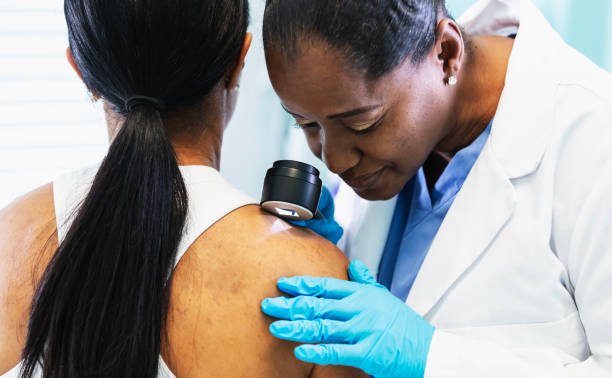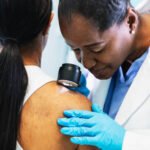Spot the danger early. Protect your skin. Save your life.
🧴 Introduction: Your Skin Is Your First Line of Defense
Your skin does more than just cover your bones and muscles — it protects your entire body, helps regulate temperature, and even reflects internal health. But despite its importance, skin is often neglected when it comes to regular health checks. That’s a problem, because skin cancer is the most common cancer globally, with millions of new cases every year.
The good news? Almost all skin cancers are treatable — and even curable — when caught early. One of the best tools for early detection is YOU. By learning how to do monthly skin self-checks and following a few expert dermatologist tips, you can take control of your skin health for life. 🩺🌿
💬 What Exactly Is Skin Cancer?
Skin cancer occurs when mutated skin cells begin to grow and divide uncontrollably, forming tumors. These abnormal cells are often caused by excessive ultraviolet (UV) radiation from the sun or tanning beds. The earlier it’s caught, the more effective the treatment — especially for aggressive forms like melanoma.
🔬 The 3 Most Common Types:
- Basal Cell Carcinoma (BCC)
- Accounts for ~80% of skin cancer cases
- Grows slowly and rarely spreads
- May look like a shiny bump, pink patch, or sore that doesn’t heal
- Squamous Cell Carcinoma (SCC)
- More aggressive than BCC
- Appears as a scaly red bump, wart-like growth, or open sore
- Can spread if untreated
- Melanoma
- Less common but most dangerous
- Can spread rapidly to other parts of the body
- Often begins in or around existing moles
👩⚕️ Melanoma causes more than 7,000 deaths per year in the U.S. — but 99% of cases are curable when caught early.
🔍 How to Do a Monthly Skin Cancer Self-Check
Set a regular reminder — maybe the 1st of each month. You’ll need:
- A full-length mirror
- A hand-held mirror
- Good lighting
- A mole map app or notebook to track changes
✅ Self-Check Steps:
- Face & Scalp
- Check the forehead, nose, eyelids, lips, ears (front and back), and use a comb or hairdryer to inspect your scalp.
- Hands & Arms
- Look at the palms, backs of hands, between fingers, under nails, wrists, forearms, and upper arms.
- Torso & Underarms
- Examine your neck, chest, and torso. Women should check under and between breasts. Lift arms to inspect underarms.
- Back & Buttocks
- Use a mirror or partner to examine your neck, shoulders, upper and lower back, buttocks, and backs of legs.
- Legs, Feet & Groin
- Inspect thighs, knees, calves, ankles, tops and soles of feet, toenails, between toes, and even your groin/genital area.
📸 Pro Tip: Take photos of your moles to track changes over time — a visual record is extremely helpful for both you and your dermatologist.
🔺 What to Look For: The ABCDE Rule
The ABCDEs of skin cancer help you identify potentially dangerous moles:
- A – Asymmetry: One half doesn’t match the other
- B – Border: Edges are jagged, blurred, or irregular
- C – Color: Multiple colors or uneven shades
- D – Diameter: Larger than 6 mm (about the size of a pencil eraser)
- E – Evolving: Changes in size, color, shape, or texture
🔁 Also look for:
- A sore that won’t heal
- A mole that starts to itch, crust, bleed, or hurt
- Any new growth that looks different from others (a “ugly duckling” mole)
🧬 Who’s at Risk?
Everyone is at some risk for skin cancer, but certain people are more vulnerable.
⚠️ High-Risk Groups:
- Fair-skinned individuals who burn easily
- People with frequent sun exposure (e.g., outdoor workers)
- Those who use tanning beds
- Anyone with 50+ moles or family history of melanoma
- Individuals with a weakened immune system (e.g., transplant patients)
- History of severe sunburns, especially in childhood
🧒 Important: Skin cancer can affect people of all skin tones, though signs may appear more subtly in darker-skinned individuals — such as under nails, on palms/soles, or inside the mouth.
🩺 When to See a Dermatologist
📆 Schedule a visit if:
- You notice a new mole or skin change that meets the ABCDE criteria
- A mole or spot looks different from all the others
- You find a sore that doesn’t heal within 3–4 weeks
- You have a personal or family history of skin cancer
🩺 Skin Screening Recommendations:
- Annual full-body exam if high-risk
- Every 2–3 years if low-risk under age 40
- More frequent checks if you’ve had skin cancer before
Dermatologists may use a dermatoscope (a special skin microscope) or perform a biopsy if something looks suspicious.
🧴 Top 6 Dermatologist-Approved Tips for Skin Protection
☀️ 1. Use Sunscreen Year-Round
- Apply broad-spectrum SPF 30+ daily — even on cloudy days
- Reapply every 2 hours when outdoors, and after swimming or sweating
- Use lip balm with SPF too!
👒 2. Embrace Sun-Safe Habits
- Wear wide-brimmed hats, UV-blocking sunglasses, and long sleeves
- Avoid sun exposure between 10 AM and 4 PM
- Use umbrellas, tents, and shade whenever possible
🧢 3. Ditch the Tanning Bed
- Tanning beds increase your melanoma risk by 75%, especially if started before age 30
🪞 4. Know Your Skin
- Regularly check for changes
- Photograph unusual moles or spots to help track changes over time
🌿 5. Practice Gentle Skin Care
- Moisturize daily to keep skin healthy and resilient
- Avoid harsh soaps and over-exfoliation
- Stay hydrated for optimal skin function
🧬 6. Boost Internal Protection
- Eat antioxidant-rich foods (like berries, leafy greens, and fish)
- These help reduce oxidative stress from sun exposure
📊 2025 Skin Cancer Facts You Should Know
- 🧍 1 in 5 Americans will develop skin cancer by age 70
- 🧬 Melanoma causes 1 death every hour in the U.S.
- 👩 90% of nonmelanoma skin cancers are caused by UV exposure
- ☁️ 80% of UV rays can pass through clouds — so sun protection is needed every day
- 📱 Mole-mapping apps and teledermatology are helping improve early detection
🌟 Final Thoughts: Prevention Is Power
Skin cancer doesn’t always come with pain — but it always comes with warning signs. By making self-checks a monthly habit and practicing sun-smart habits, you can catch skin cancer early or prevent it altogether. 🧡
It’s time to treat your skin like the vital organ it is. Because when you know your skin, you can protect your life.
So go ahead — set a reminder, grab a mirror, and start your check today. Your future self will thank you. 🌞💪
💬 Have a story about skin cancer, sun protection tips, or mole tracking tools that work for you? Share your experience — you could help save a life.👇







Leave a Reply